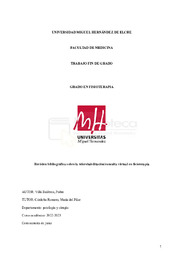Título :
Revisión bibliográfica sobre la telerehabilitación/consulta virtual en fisioterapia |
Autor :
Villa Balibrea, Pedro |
Tutor:
Córdoba Romero, María del Pilar |
Editor :
Universidad Miguel Hernández |
Departamento:
Departamentos de la UMH::Patología y Cirugía |
Fecha de publicación:
2023-06-16 |
URI :
https://hdl.handle.net/11000/30244 |
Resumen :
Contexto
A raíz de la pandemia del SARS-CoV-2, la telerehabilitación en fisioterapia tomó fuerza y fue muy
empleada desde entonces. Muchas patologías han sido tratadas con este modelo desde entonces, con
resultados a priori positivos.
Objetivo
El objetivo de esta revisión bibliográfica fue conocer qué dice la literatura sobre la eficacia y los
puntos fuertes de la telerehabilitación de fisioterapia para así promover a los fisioterapeutas su uso.
Métodos
Se realizó una búsqueda en las bases de datos Scopus, PEDro, Pubmed, Cochrane y ScienceDirect. Se
excluyeron estudios que fueran revisiones sistemáticas o metaanálisis. Los artículos debían mencionar
que el tratamiento fuera fisioterapéutico. Se evaluaron dichos estudios mediante la escala de calidad
PEDro y se extrajeron los datos obtenidos.
Resultados
25 estudios fueron seleccionados finalmente, atendiendo a los criterios correspondientes. Las
investigaciones mostraron que del total de artículos encontrados, en el 48% hubo una mejoría general
acerca de la telerehabilitación respecto a la consulta presencial, y en el 16% costes menores entre
ambas modalidades, con un 0% de estudios que reflejaran mayores costes económicos. Casi el 20%
demostró una adherencia mayor al tratamiento, no encontrándose ninguna investigación que
mencionara una menor adherencia por parte del paciente.
Conclusión
Los estudios sugieren que es una buena terapia alternativa a nivel funcional, económico y de
adherencia del paciente. Sin embargo, hay pocos artículos que traten detalladamente el beneficio
económico exacto y sería interesante que se realizaran más estudios al respecto.
Context
As a result of the SARS-CoV-2 pandemic, telerehabilitation in physiotherapy gained strength and has
been widely used since then. Many pathologies have been treated with this model, with a priori
positive results.
Objective
The objective of this bibliographic review was to find out what the literature says about the efficacy
and strengths of physiotherapy telerehabilitation in order to promote its use by physiotherapists.
Methods A search was carried out in the Scopus, PEDro, Pubmed, Cochrane and ScienceDirect databases.
Studies that were systematic reviews or meta-analyses were excluded. Articles had to mention that the
treatment was physiotherapeutic. These studies were evaluated using the PEDro quality scale and the
data obtained were extracted.
Results
25 studies were finally selected, according to the corresponding criteria. The investigations showed
that of the total number of articles found, in 48% there was a general improvement regarding
telerehabilitation compared to face-to-face consultation, and in 16% lower costs between both
modalities, with 0% of studies reflecting higher economic costs. Almost 20% demonstrated greater
adherence to treatment, not finding any research that mentioned less adherence by the patient.
Conclusion
Studies suggest that it is a good alternative therapy at the functional, economic and patient adherence
level. However, there are few articles that deal in detail with the exact economic benefit and it would
be interesting if more studies were carried out in this regard.
|
Palabras clave/Materias:
physiotherapy
telerehabilitation
telehealth
remote physical therapy
home-based physical therapy |
Área de conocimiento :
CDU: Ciencias aplicadas |
Tipo de documento :
info:eu-repo/semantics/bachelorThesis |
Derechos de acceso:
info:eu-repo/semantics/openAccess
Attribution-NonCommercial-NoDerivatives 4.0 Internacional |
Aparece en las colecciones:
TFG - Fisioterapia
|
 La licencia se describe como: Atribución-NonComercial-NoDerivada 4.0 Internacional.
La licencia se describe como: Atribución-NonComercial-NoDerivada 4.0 Internacional.
.png)
